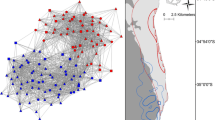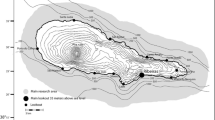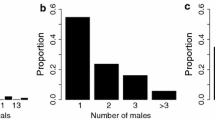Abstract
The role of relatedness in structuring animal societies has attracted considerable interest. Whilst a significant number of studies have documented kin recognition in shoaling fish under laboratory conditions, there is little evidence that relatedness plays a significant role in structuring social interactions in wild populations that are characterised by fission–fusion dynamics. Previous work has tended to compare relatedness within and among entire shoals. Such an approach however, does not have the ability to detect social sub-structuring within groups, which appears to be a major factor driving the social organisation of fission–fusion animal societies. Here, we use social network analysis combined with DNA microsatellite genotyping to examine the role of relatedness in structuring social relationships in a wild population of guppies (Poecilia reticulata). Consistent with previous findings, female–female dyads formed the strongest social relationships, which were stable over time. Interestingly, we also observed significant co-occurrence of male–male interactions, which is in contrast to previous work. Although we observed social sub-structuring in the population, we found no evidence for relatedness playing a significant role in underpinning this structure. Indeed, only seven first-degree relative dyads were identified among the 180 fish genotyped, indicating that the majority of individuals do not have a first-degree relative in the population. The high genetic diversity observed in this population is indicative of a large effective population size typical of lowland guppy populations. We discuss our findings in the context of the evolution of social organisation and the mechanisms and constraints that may drive the observed patterns in wild populations.




Similar content being viewed by others
References
Barson NJ, Cable J, Van Oosterhout C (2009) Population genetic analysis of microsatellite variation of guppies (Poecilia reticulata) in Trinidad and Tobago: evidence for a dynamic source—sink metapopulation structure, founder events and population bottlenecks. J Evol Biol 22:485–497
Becher SA, Russell ST, Magurran AE (2002) Isolation and characterization of polymorphic microsatellites in the Trinidadian guppy (Poecilia reticulata). Mol Ecol Notes 2:456–458
Brown GE, Brown JA (1993) Social dynamics in salmonid fishes—do kin make better neighbours. Anim Behav 45:863–871
Brown GE, Brown JA, Wilson WR (1996) The effects of kinship on the growth of juvenile Arctic charr. J Fish Biol 48:313–320
Chivers DP, Brown GE, Smith RJF (1995) Familiarity and shoal cohesion in fathead minnows (Pimephales promelas)—implications for antipredator behaviour. Can J Zool 73:955–960
Croft DP, Albanese B, Arrowsmith BJ, Botham M, Webster M, Krause J (2003a) Sex biased movement in the guppy (Poecilia reticulata). Oecologia 137:62–68
Croft DP et al (2003b) Mechanisms underlying shoal composition in the Trinidadian guppy (Poecilia reticulata). Oikos 100:429–438
Croft DP, Arrowsmith BJ, Webster M, Krause J (2004a) Intrasexual preferences for familiar individuals in male guppies (Poecilia reticulata). J Fish Biol 64:279–283
Croft DP, Darden SK, Ruxton GD (2009a) Predation risk as a driving force for phenotypic assortment: a cross-population comparison. Proc R Soc Lond B 276(1663):1899–1904
Croft DP, James R, Krause J (2008) Exploring animal social networks. Princeton University Press, Princeton
Croft DP et al (2006) Social structure and co-operative interactions in a wild population of guppies (Poecilia reticulata). Behav Ecol Sociobiol 59:644–650
Croft DP, Krause J, Darden SK, Ramnarine IW, Faria JJ, James R (2009b) Behavioural trait assortment in a social network: patterns and implications. Behav Ecol Sociobiol 63:1495–1503
Croft DP, Krause J, James R (2004b) Social networks in the guppy (Poecilia reticulata). Proc R Soc Lond B 271:S516–S519
Crowley PH (1992) Resampling methods for computation-intensive data-analysis in ecology and evolution. Annu Rev Ecol Syst 23:405–477
Darden SK, James R, Ramnarine IW, Croft DP (2009) Social implications of the battle of the sexes: sexual harassment disrupts female sociality and social recognition. Proc R Soc Lond B 276:2651–2656
Dowling TE, Moore WS (1986) Absence of population subdivision in the common shiner, Notropis cornutus (Cyprinidae). Environ Biol Fish 15:151–155
Dugatkin LA (1988) Do guppies play tit for tat during predator inspection visits? Behav Ecol Sociobiol 23:395–399
Dugatkin LA (1992) Tendency to inspect predators predicts mortality risk in the guppy (Poecilia reticulata). Behav Ecol 3:124–127
Estoup A, Largiader CR, Perrot E, Chourrout D (1996) Rapid one-tube DNA extraction for reliable PCR detection of fish polymorphic markers and transgenes. Mol Mar Biol Biotech 5:295–298
Evans JP, Kelley JL (2008) Implications of multiple mating for offspring relatedness and shoaling behaviour in juvenile guppies. Biol Lett 4:623–626
Fitzgerald GJ, Morrissette J (1992) Kin recognition and choice of shoal mates by three-spine sticklebacks. Ethol Ecol Evol 4:273–283
Fletcher JA, Doebeli M (2009) A simple and general explanation for the evolution of altruism. Proc R Soc Lond B 276:13–19
Gerlach G, Hodgins-Davis A, MacDonald B, Hannah R (2007) Benefits of kin association: related and familiar zebrafish larvae (Danio rerio) show improved growth. Behav Ecol Sociobiol 61:1765–1770
Godin JGJ, Davis SA (1995) Who dares, benefits: predator approach behaviour in the guppy (Poecilia reticualta) deters predator pursuit. Proc R Soc Lond B 259:193–200
Grether GF, Millie DF, Bryant MJ, Reznick DN, Mayea W (2001) Rain forest canopy cover, resource availability, and life history evolution in guppies. Ecology 82:1546–1559
Griffiths SW (2003) Learned recognition of conspecifics by fishes. Fish Fish 4:256–268
Hain TJA, Neff BD (2007) Multiple paternity and kin recognition mechanisms in a guppy population. Mol Ecol 16:3938–3946
Hamilton WD (1964) The genetical evolution of social behaviour. I J Theor Biol 7:1–16
Hatchwell BJ (2010) Cryptic kin selection: kin structure in vertebrate populations and opportunities for kin-directed cooperation. Ethology 116:203–216
Hughes KA, Du L, Rodd FH, Reznick DN (1999) Familiarity leads to female mate preference for novel males in the guppy, Poecilia reticulata. Anim Behav 58:907–916
Jones OR, Wang J (2009) COLONY: a program for parentage and sibship inference from multi locus genotype data. Mol Ecol Resour 10:551–555
Kalinowski S, Wagner A, Taper M (2006) ML-RELATE: a computer program for maximum likelihood estimation of relatedness and relationship. Mol Ecol Notes 6:576–579
Kelley JL, Graves JA, Magurran AE (1999) Familiarity breeds contempt in guppies. Nature 401:661–662
Klimley AP, Holloway CF (1999) School fidelity and homing synchronicity of yellowfin tuna, Thunnus albacares. Mar Biol 133:307–317
Krause J, Croft DP, James R (2007) Social network theory in the behavioural sciences: potential applications. Behav Ecol Sociobiol 62:15–27
Krause J, Ruxton GD (2002) Living in groups. Oxford University Press, Oxford
Landeau L, Terborgh J (1986) Oddity and the confusion effect in predation. Anim Behav 34:1372–1380
Magurran AE (2005) Evolutionary ecology: the Trinidadian guppy. Oxford University Press, Oxford
Magurran AE, Higham A (1988) Information transfer across fish shoals under predator threat. Ethology 78:153–158
Magurran AE, Seghers BH (1994) Sexual conflict as a consequence of ecology—evidence from guppy, Poecilia reticulata, populations in Trinidad. Proc R Soc Lond B 255:31–36
Metcalfe NB, Thomson BC (1995) Fish recognise and prefer to shoal with poor competitors. Proc R Soc Lond B 259:207–210
Milinski M (1987) Tit-for-tat in sticklebacks and the evolution of cooperation. Nature 325:433–435
Milinski M, Külling D, Kettler R (1990) Tit for tat: sticklebacks (Gasterosteus aculeatus) “trusting” a cooperating partner. Behav Ecol 1:7–11
Milinski M, Luthi JH, Eggler R, Parker GA (1997) Cooperation under predation risk: experiments on costs and benefits. Proc R Soc Lond B 264:831–837
Milligan B (2003) Maximum-likelihood estimation of relatedness. Genetics 163:1153–1167
Naish KA, Carvalho GR, Pitcher TJ (1993) The genetic-structure and microdistribution of shoals of Phoxinus phoxinus, the European minnow. J Fish Biol 43:75–89
Neill SR, ST J, Cullen JM (1974) Experiments on whether schooling by their prey affects the hunting behaviour of cephalopods and fish predators. J Zool 172:549–569
Nowak MA, Tarnita CE, Antal T (2010) Evolutionary dynamics in structured populations. Philos Trans R Soc Lond B 365:19–30
Ohguchi O (1978) Experiments on the selection against colour oddity of water fleas by three-spined stickelbacks. Z Tierpsychol 47:254–267
Olsén KH, JäUrvi T (1997) Effects of kinship on aggression and RNA content in juvenile Arctic charr. J Fish Biol 51:422–435
Paterson IG, Crispo E, Kinnison MT, Hendry AP, Bentzen P (2005) Characterization of tetranucleotide microsatellite markers in guppy (Poecilia reticulata). Mol Ecol Notes 5:269–271
Peakall R, Smouse PE (2006) Genalex 6: genetic analysis in excel. Population genetic software for teaching and research. Mol Ecol Notes 6:288–295
Peuhkuri N, Seppa P (1998) Do three-spined sticklebacks group with kin? Ann Zool Fenn 35:21–27
Pitcher TJ, Green DA, Magurran AE (1986) Dicing with death—predator inspection behaviour in minnow shoals. J Fish Biol 28:439–448
Pitcher TJ, Magurran AE, Allan JR (1983) Shifts of behaviour with shoal size in Cyprinids. In: Proceedings of the 3rd British Freshwater Fish Conference, University of Liverpool, Liverpool, pp 220–228
Piyapong C, Butlin RK, Faria JJ, Scruton KJ, Wang J, Krause J (2011) Kin assortment in juvenile shoals in wild guppy populations. Heredity 106:749–756
Platt TG, Bever JD (2009) Kin competition and the evolution of cooperation. Trends Ecol Evol 24:370–377
Raymond M, Rousset F (1995) GENEPOP (version 1.2): population genetics software for exact tests and ecumenicism. J Hered 86:248–249
Reznick DN, Butler MJ, Rodd FH, Ross P (1996) Life-history evolution in guppies (Poecilia reticulata). 6. Differential mortality as a mechanism for natural selection. Evolution 50:1651–1660
Rice WR (1989) Analyzing tables of statistical tests. Evolution 43:223–225
Rousset F (2008) GENEPOP’007: a complete re-implementation of the GENEPOP software for Windows and Linux. Mol Ecol Resour 8:103–106
Russell ST, Kelley JL, Graves JA, Magurran AE (2004) Kin structure and shoal composition dynamics in the guppy, Poecilia reticulata. Oikos 106:520–526
Schradin C (2000) Confusion effect in a reptilian and a primate predator. Ethology 106:691–700
Shen X, Yang G, Liao M (2007) Development of 51 genomic microsatellite DNA markers of guppy (Poecilia reticulata) and their application in closely related species. Mol Ecol Notes 7:302–306
Sih A, Hanser SF, McHugh KA (2009) Social network theory: new insights and issues for behavioural ecologists Behav. Ecol Sociobiol 63:975–988
Swaney W, Kendal J, Capon H, Brown C, Laland KN (2001) Familiarity facilitates social learning of foraging behaviour in the guppy. Anim Behav 62:591–598
Theodorakis CW (1989) Size segregation and the effects of oddity on predation risk in minnow schools. Anim Behav 38:496–502
Utne-Palm AC, Hart PJB (2000) The effects of familiarity on competitive interactions between three-spined sticklebacks. Oikos 91:225–232
Van Havre N, Fitzgerald GJ (1988) Shoaling and kin recognition in the three-spine Stickleback (Gasterosteus aculeatus L.). Biol Behav 13:190–201
Van Oosterhout C, Hutchinson WF, Wills DPM, Shipley P (2004) Micro-checker: software for identifying and correcting genotyping errors in microsatellite data. Mol Ecol Notes 4:535–538
Ward AJW et al (2002) Association patterns and shoal fidelity in the three-spined stickleback. Proc R Soc Lond B 269:2451–2455
Ward AJW, Hart PJB (2003) The effects of kin and familiarity on interactions between fish. Fish Fish 4:348–358
Watanabe T, Yoshida M, Nakajima M, Taniguchi N (2003) Isolation and characterization of 43 microsatellite DNA markers for guppy (Poecilia reticulata). Mol Ecol Notes 3:487–490
West SA, Murray MG, Machado CA, Griffin AS, Herre EA (2001) Testing Hamilton’s rule with competition between relatives. Nature 409:510–513
West SA, Pen I, Griffin AS (2002) Cooperation and competition between relatives. Science 296:72–75
Acknowledgments
We thank D. Thomas and J.B. Brask for assistance in the field. Funding was provided to D.P.C. and S.K.D. by the Leverhulme Trust and to C.R.T. by the Natural Environmental Research Council (NERC) Grant no. NE/G019355/1.
Author information
Authors and Affiliations
Corresponding author
Additional information
Communicated by Øyvind Fiksen.
Rights and permissions
About this article
Cite this article
Croft, D.P., Hamilton, P.B., Darden, S.K. et al. The role of relatedness in structuring the social network of a wild guppy population. Oecologia 170, 955–963 (2012). https://doi.org/10.1007/s00442-012-2379-8
Received:
Accepted:
Published:
Issue Date:
DOI: https://doi.org/10.1007/s00442-012-2379-8




